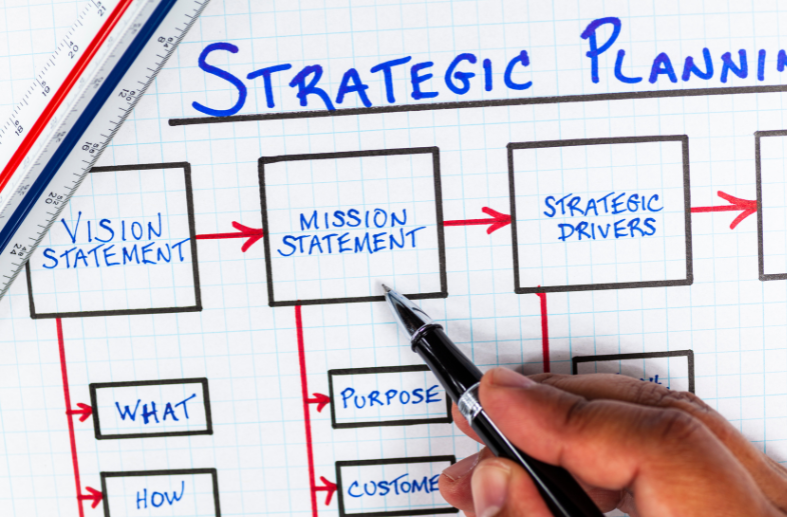
Defining Strategic Planning
Strategic planning is essentially setting long-term goals that the organization creates a plan to meet [1]. This step usually starts with senior leadership and requires top-down and bottom-up efforts to initiate a company-wide change. When talking about strategic planning, it’s important to remember the role of organizational governance in healthcare. Organizational governance applies to the improvement of the operations, clinical practice, and performances of various structures and processes [2]. Strategic planning is the start of the process and requires leadership to establish the anticipated goals of the business. It is important that customer experience remains a top priority throughout the process. Oftentimes, strategic planning can be due to a catalyst from a situation that lacked customer focus. This requires changes to be made to refocus the priorities back on customer experience.

Since strategic planning should focus on customer experiences, it’s important that the capabilities of the business also line up with customer priorities. This is essential because customers are the ones who will eventually be using the product. Therefore, it’s important to take the time to conduct surveys and set functional requirements that address the needs of the customers. Moreover, all aspects of strategic planning need to create short, medium, and long-term initiatives that focus on customer experience and needs. When thinking of strategic planning, it’s important to ask where the business is today, where it should be in the future, what can be done to get the business there, and if the business is on track to get there [3]. In return, businesses that incorporate customer-focused objectives into their strategic planning often have better returns on their investments, performances, and overall impacts.
The Process of Creating Strategic Plans
Strategic plans start with initial planning, which requires creating the scope and an organized planning process to determine functional requirements [3]. It is crucial to start incorporating customer experience in this step because the objectives should line up with user needs. The next step is to collect data and define the current state of the company. Information on trends, current customer satisfaction, and performance history should be collected at this step. The end result should be an assessment of where the business stands and a list of current issues and areas that don’t meet user needs.

Afterwards, the company should create a mission statement which includes short and long-term goals to meet the desired outcomes. Customer experience should also be focused on during this stage to ensure that issues are addressed and mitigated. Oftentimes, senior leadership will brainstorm with stakeholders on the best way to implement and meet functional requirements [3]. This step should also result in volume projections for the success of the new implementation [3]. Finally, the last step is to develop and approve the final plan. This requires stakeholders and senior leadership to finalize a plan on how they would like to move forward and the best way to implement change. Overall, human-centered design should play a part throughout the entire strategic planning process.
The Process of Implementing the Strategic Plan
Once a final strategic plan is developed, the company will then have to implement it. This requires creating a timeline for the objectives and setting responsibilities for the leadership involved in the implementation [3]. The implementation planning process should also include a list of all the resources that will be needed and ways that the departments can organize their resources [3]. This is also the step where government affairs and an effective line of communication will be established [3]. Next, leadership should decide how often the plan should be evaluated, and how often updates will be provided to stakeholders [3]. This assessment should include important metrics depending on the set objectives. Furthermore, mitigations should also be created in order to promote the plan’s success and to ensure that functional requirements are met. This process requires routine collaboration and may require an adjustment to resources and the timeline as needed.

Once the implementation plan is created, it’s important to create a communications plan to involve all parties related to the implementation and the success of the service [3]. This may include talking to government facilities, stakeholders, faculty, politicians, and more [3]. Overall, this step is important because it promotes communication and pushes the strategic plan to success through various interactions and prioritization. As the process is implemented, it’s important to go back to the established assessments and track the success of the strategic planning process. Leadership and stakeholders should continue to communicate to ensure that progress is being made and that the targets are being met for each of the established metrics [3].
Overcoming the Challenges of Strategic Planning
Oftentimes, strategic planning may be difficult to implement due to common challenges. The first one is a lack of ownership, particularly with senior leadership failing to take on responsibility and follow through with the plan [4]. One way to prevent this is by creating objectives and a key results framework where roles and expectations are clearly stated and follow-up is required on all tasks [4]. Another challenge is poor communication which can disrupt the flow and timeline of the goals [4]. One way to prevent this is by promoting collaborations digitally and using different tools depending on what works best for your team. Next, another common challenge is the lack of alignment, which can happen when not everyone is on the same page about the roles of the business. This can be mitigated by collaborating with your team and providing feedback to ensure goals are met.

The last challenge is slow adoption, which occurs due to delays in the plan or a lack of a focused adoption of the plan [4]. This can be due to outdated policies and resistance from coworkers. This can be prevented with continuous reminders and check-ins to ensure that everyone is on the same page. Additionally, it’s important to create a structured strategic plan which clearly lists out the goals, objectives, and tasks at hand, as well as who will be responsible for completing them. Moreover, catering training sessions to your team will avoid delays and resistance to change, and help promote satisfied coworkers. Laslty, it’s important to incorporate data and analytics when creating a plan so that the priorities are backed up with realistic goals and expectations [4].
HITS
HITS provides organizational governance services that focus on strategic planning by utilizing internal and external levers in government to fold customer experience into the organization. Furthermore, HITS promotes human-centered design in the organizational governance process by expediting decision-making for both internal and external leadership. This increases the deliverables provided for patients and healthcare providers. HITS also collaborates with various experts and researches best practices related to the development of the Capability Development Documents. Overall, HITS is able to provide best practices and processes through appropriate governance and the use of strategic planning so that future projects continue focusing on human-centered solutions that promote customer experience.
References
- https://www.stratadecision.com/blog/why-strategic-planning-is-important-in-healthcare/
- https://www.boardeffect.com/blog/role-governance-healthcare-organizations/
- https://www.aamc.org/career-development/affinity-groups/gip/strategic-planning
- https://lucidspark.com/blog/the-pitfalls-of-strategic-planning#:~:text=There%20are%20four%20main%20challenges,before%20we%20dive%20into%20solutions.